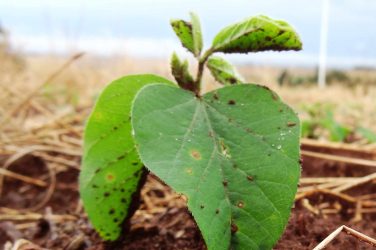Nearly ten percent of all the deforestation occurring in the Brazilian Amazon between 2005 and 2015 came from mining activities, say researchers in a new study — a stunning statistic far higher than the 1 to 2 percent noted in previous global assessments.
The reason for the difference is that past research only looked at the mines themselves, and not at the ancillary development that accompanies and surrounds the mines.
Using satellite data, the researchers found that deforestation from mining encompassed 11,670 square kilometers (roughly 4,500 square miles) between 2005 and 2015, an area twice the size of the state of Delaware.
The startling level of Amazon deforestation, they say, demands immediate action on the part of mining companies and government — especially because Brazil’s Temer administration seems intent on opening vast swathes of the country to mining in the near future.
The international group of researchers, organized around the University of Vermont, published their findings in the journal Nature Communications.
The research used satellite monitoring to study the fifty largest mining sites in the Amazon region, and analyzed the rates of deforestation in and around those sites between 2005 and 2015.
Strikingly, the study found that deforestation outside of and surrounding the mining-lease areas removes twelve times as many trees as within the lease boundaries.
Further, this loss extends to as much as 70 kilometers (approximately 43 miles) from the lease areas as infrastructure such as roads, staff housing, and airports cut into the forest.
“Our findings show that Amazon deforestation associated with mining extends remarkable distances from the point of mineral extraction,” said Gillian Galford, a study co-author with the Gund Institute and Rubenstein School of Environment and Natural Resources at the University of Vermont (UVM).
Meanwhile, a preliminary study from Brazil’s space agency, INPE, found that deforestation in Brazil decreased 16 percent between August 2016 and July 2017.
Laura Sonter, a co-author of the UVM study and also with the Gund Institute and Rubenstein School, warned that the INPE finding doesn’t mean things are fine: “The problem is that deforestation rates are still up over the last 3 years compared to years before that, and a drop in deforestation still means that 6,624 square kilometers [some 2,557 square miles] of Amazon forest was cleared [from August 2016 to July 2017].
Additionally, deforestation rates are expected to increase again next year, due to the current drought and expected rural fires.” Amazon wildfires are at record levels this year, with most of them caused by people.
Sonter told Mongabay that the UVM research is significant because of the way it reassesses the impact mining has on deforestation. “Mining is typically thought to cause about 1 percent of tropical deforestation worldwide, but our results suggest impacts are almost 10 times greater than this.
“We found most deforestation occurred outside mining leases and we were also surprised to find these off-lease impacts to extend 70 kilometers from the site of operation. Previous estimates suggest indirect effects occur only up to 10 kilometers.”
“The threats and potential consequences of mining on deforestation in the Amazon are significant,” Sonter added.
These findings come as Brazil’s government considers a series of measures to ease restrictions on mining in the Amazon region. In August, an international outcry spurred the country’s judiciary to block President Temer’s plans to open up the RENCA reserve to mining.
The reserve covers 4.6 million hectares (17,800 square miles), an area roughly equal to Denmark. RENCA holds minerals such as gold, nickel and manganese, but it is also rich in biodiversity with large tracts of rainforest and numerous protected conservation units. The area is also home to two indigenous reserves, which experts say would be put at serious risk if mining operations began nearby.
Pará state deputy Eduardo Costa said that he suspects that the areas affected by deforestation due to mining “are much greater than the figure the study presents.”
He explained that although pig-iron smelters are not as active in the Amazon region as they once were, the remaining facilities still use charcoal obtained from wood. “Maybe 90 percent of the wood that was used in these ovens that process pig-iron came from illegal sources, and this created a big impact on deforestation.”
A 2012 report in Carta Capital pointed to criminal activities in the pig-iron production chain, including illegal charcoal operations, bribes and slave labor.
In August, the Brazilian forest research institute IMAZON noted that a Temer administration decree to reduce protections for the Jamanxim National Forest would also benefit mining companies.
Although the measure ordering this reduction was vetoed, the president has since re-submitted the rollback in the conserved area’s size under a bill to congress, and experts believe it is likely to be approved.
Brazil’s Ministry of Mines and Energy said that it was unprepared to comment on the study presented in Nature Communications or on measures the government is taking to prevent deforestation. A representative of the country’s mining agency did not respond to calls or an email request for comment.
Nilo D’Avila manages Greenpeace’s campaigns in Brazil. He said that Greenpeace wasn’t surprised by the study findings. “The government uses [the Carajás mine] as an example of mining and [forest] preservation. But when we look around the Carajás mine, we find deforestation that is much higher than average.”
Carajás is an open-pit mine operated by the Vale Mining Company in the Amazonian state of Pará. It is the world’s largest iron mine. Located within the Carajás National Forest, it is estimated to contain 7.2 billion tons of iron.
The Carajás mine serves as an example of the economic potential of mining and of mining’s environmental impact in the Amazon region. Iron ore is Brazil’s largest mineral export and accounts for 10 percent of the country’s total exports. However, satellite time-lapse photography from the UVM study shows how the mine has contributed to deforestation.
D’Avila said that the government is considering easing mining restrictions in a vast area along Brazil’s northern and western borders — a mostly wild region 300 times the size of RENCA, covering 1.7 million square kilometers of the Amazon biome.
These are “areas that are still not designated [as protected], with few conservation areas. Brazil has few relationships, especially in the Amazon region, with its neighbors. So, the Brazilian government sees a way of having business relationships with these countries through mining, road construction, through ‘progress.'”
The findings of the UVM study clearly demonstrate that opening such a large area of native forest to mining and its accompanying infrastructure would result in significant deforestation.
Also, just as clearly, mining companies are eager to enlarge their Amazonian footprint: “Throughout Brazil, mining leases, concessions, and exploration permits cover 1.65 million square kilometers [637,068 square miles] of land, of which 60 percent is located in the Amazon forest,” notes the UVM study.
A closer look at the Carajás mine shows what could lie ahead environmentally for the Amazon and other parts of Brazil if these many leases, concessions and exploration permits are allowed to advance. A railway carries the iron from the Carajás mine to foundries in Bacarena and São Luís.
Both the mine and the railway were funded by the World Bank in the 1980s. Residents have been fighting to stop the company from doubling the rail line for years. One reason for the battle, Brazil’s G1 news outlet reported earlier this year, is the number of people who are killed or maimed by the freight trains.
Also, the Indigenous Missionary Council (CIMI) and other human rights groups say that the doubling of the railway was approved before an environmental impact assessment was completed and without consulting the indigenous communities affected, a violation of Brazil’s international agreements.
Prof. Philip Fearnside, who studies hydroelectric dams in the Amazon region, spoke about the Carajás mine. “Aside from the hole in the ground, the big impact is the charcoal [used to process the ore]. What limits that is these pig-iron smelters, not the amount of ore that is dug out.”
In May of this year, Brazil’s environmental agency, IBAMA, destroyed 66 illegal ovens for producing charcoal in northeastern Pará. Between 1998 and 2014, deforestation in Pará outpaced all other states in the Amazon region, and mining contributed to that impact.
The Carajás mine is largely powered by hydroelectricity from the Tucuruí dam, which brings up another major concern. Environmental impact assessments for proposed mines in Brazil don’t cover the massive energy requirements for processing ore, energy which in the Amazon generally comes from hydroelectric dams.
Hydropower has its own suite of environmental hazards, including deforestation, major greenhouse gas releases from reservoirs, and disrupted aquatic and terrestrial ecosystem. Dams, like mines, also bring ancillary development, as laborers arrive in a region to build infrastructure, and then settle locally.
Dams also bring new roads and transmission lines. They often do substantial social harm as well, disrupting and displacing indigenous and traditional riverine settlements.
Mining, experts agree, is both a boon and bane to modern civilization: it provides critical materials for everyday items ranging from cell phones and computers to cars and home appliances. But without regulation it can cause major deforestation and pollute rivers and aquifers.
Iron tailings dam collapse that killed 19 people and contaminated 500 miles of the Rio Doce all the way to the Atlantic Ocean — Brazil’s worst environmental disaster — is a warning to the nation and the world of what can happen when mining profits trump environmental protection and public safety, say experts.
Sonter suggested one important step Brazil could take to minimize mining-related deforestation: require an assessment not only of the immediate on-site impacts of mines, but also of off-lease impacts prior to approving projects.
“With this information, action can then be taken to avoid, reduce and mitigate [impacts]. Avoidance measures could involve siting new roads in areas of degraded and cleared [land], rather than through intact pristine forest.
Mitigation efforts may involve establishment and management of new protected areas in the surrounding landscape to prevent further deforestation.” Likewise, assessments should review whether new Amazon mines will require new hydroelectric dams to power the ore’s processing.
Considering the threat that mining poses to Amazonian forests, and the crucial importance of the region’s forests to carbon storage and to curbing climate change, controlling mining impacts could be crucial to the future of both Brazil and the planet.
Galford is hopeful that the UVM study’s findings will lead to positive action: “Many of these [mining] corporations may take this as an opportunity to step up and take responsibility for off-site deforestation. In fact, the world may demand it.”
Citation:
Sonter, L. J., Herrera, D., Barrett, D. J., Galford, G. L., Moran, C. J., Soares-Filho, B. S.: (2017) Mining drives extensive deforestation in the Brazilian Amazon. Nature Communications; DOI: 10.1038/s41467-017-00557-w
This article appeared originally in Mongabay – https://news.mongabay.com













